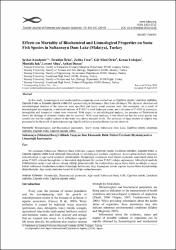Effects on mortality of biochemical and limnological properties on some fish species in Sultansuyu Dam Lake (Malatya), Turkey

View/
xmlui.dri2xhtml.METS-1.0.item-rights
info:eu-repo/semantics/openAccessDate
2010Author
Şevket Kandemirİbrahim Örün
Zeliha Talas
Gül Nihal Örün
Kenan Erdoğan
Mustafa Işık
Levent Altaş
Ayhan Duran
Metadata
Show full item recordAbstract
Bu çalışmada Sultansuyu (Malatya) Baraj Gölü’nde yaşayan Cyprinus carpio, Leuciscus cephalus, Capoeta trutta ve Capoeta capoeta umbla balık türlerinde hematolojik ve biyokimyasal inceleme yapılmıştır. Ayrıca gölün fiziksel, kimyasal, mikrobiyolojik ve ağır metal analizleri yürütülmüştür. Hematolojik incelemede total lökosit sayılarında istatistiksel olarak bir artma P<0,05, eritrosit hemoglobin ve hematokrit değerlerinde bir azalma P<0,05 olduğu saptanmıştır. Mikrobiyal analizde Enterococcus varlığı evsel atıkların drenaj edildiği göstermektedir. Su analizlerinden suyun ikince kalite su olduğu ve suyun kükürt miktarının standartların üstünde bulunduğu belirlenmiş olup, kaynağının yörede yapılan kayısıcılıktan kaynaklandığı düşünülmüştür. Ağır metal yönünden önemli bir kirliliğe rastlanılmamıştır. In this study, hematological and biochemical investigations were carried out on Cyprinus carpio, Leuciscus cephalus, Capoeta trutta ve Capoeta capoeta umbla fish species living in Sultansuyu Dam Lake (Malatya). The physical, chemical and microbiological features of the reservoir were specified and heavy metal analyses were also conducted. As a result of hematological investigation, a statistical increase of P<0.05 in total leukocyte count, and a decrease of P<0.05 in erytrocyte, hemoglobin and hematocrit values were observed. With respect to microbiological analysis, the presence of Enterococcus shows the drainage of domestic wastes into the reservoir. With water analyses, it was found out that the water quality was second rate and the sulphur content in the water was above standard levels. The existence of large amount of sulphur was presumed to be the result of apricot processing. Significant heavy metal pollution was not observed.
Source
Turkish Journal of Fisheries and Aquatic SciencesVolume
10Issue
3URI
https://app.trdizin.gov.tr/publication/paper/detail/TVRBNE5qSTJOZz09https://hdl.handle.net/20.500.12450/45

















